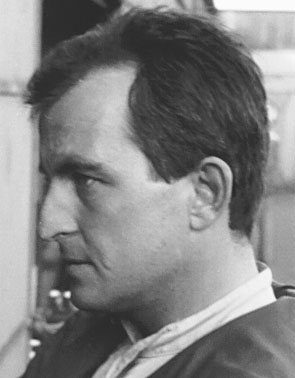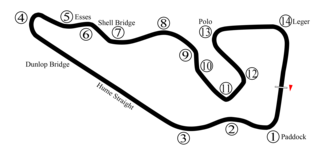
The Albert Park Circuit is a motorsport street circuit around Albert Park Lake, three kilometres south of central Melbourne. It is used annually as a circuit for the Formula One Australian Grand Prix, the supporting Supercars Championship Melbourne 400 and other associated support races. The circuit has an FIA Grade 1 license.

The Australian Grand Prix is an annual motor racing event which is under contract to host Formula One until 2035. One of the oldest surviving motorsport competitions held in Australia, the Grand Prix has moved frequently with 23 different venues having been used since it was first run at Phillip Island in 1928. The race became part of the Formula One World Championship in 1985. Since 1996, it has been held at the Albert Park Circuit in Melbourne, with the exceptions of 2020 and 2021, when the races were cancelled due to the COVID-19 pandemic. Before that, it was held in Adelaide.

Ludovico Scarfiotti was a Formula One and sports car driver from Italy. Just prior to entering Formula One, he won the 1963 24 Hours of Le Mans for Ferrari. He later participated in 12 World Championship Formula One grands prix, and many non-championship races. He won one World Championship race, and scored a total of 17 championship points. A motor sports competitor for a decade, Scarfiotti won the 1962 and 1965 European Hillclimb Championship. He was proclaimed Italy's best driver in both 1962 and 1965.

The Longford Circuit was a temporary motor racing course laid out on public roads at Longford, 23-kilometre (14 mi) south-west of Launceston in Tasmania, Australia. It was located on the northern edges of the town and its 7.242 km (4.500 mi) lap passed under a railway line viaduct, crossed the South Esk River via the wooden Kings Bridge, turned hard right at the doorstep of the Longford Hotel, passed over the railway line using a level crossing and traversed the South Esk again via another wooden structure, the Long Bridge.
The 1932 Australian Grand Prix was a motor race held at the Phillip Island circuit in Victoria, Australia on 14 March 1932. It was the fifth Australian Grand Prix and the fifth to be held at Phillip Island.

The 1963 Australian Grand Prix was a motor race held at Warwick Farm Raceway in New South Wales, Australia on 10 February 1963. Open to Formula Libre cars, it was the opening heat of the 1963 Australian Drivers' Championship. The race, which was the twenty eighth Australian Grand Prix, had 16 starters.
David McKay was an Australian journalist and prominent motoring identity.
Doug Whiteford was an Australian racing driver.

The 1959 Australian Grand Prix was a Formula Libre motor race held at the Longford Circuit in Tasmania, Australia on 2 March 1959.

The 1958 Australian Grand Prix was a motor race for Formula Libre racing cars, held at the Mount Panorama Circuit, near Bathurst in New South Wales, Australia on 6 October 1958. The race had 26 starters. It was the first Australian Grand Prix to specifically exclude sports cars from the entry.
The 1956 Australian Grand Prix was a motor race for Formula Libre cars held at Albert Park Street Circuit, in Victoria, Australia on 2 December 1956. The race, which had 22 starters, was held over 80 laps of the five kilometre circuit, the longest of all the Australian Grands Prix at 402 kilometres. It attracted a crowd of over 120,000 spectators.
The 1954 Australian Grand Prix was a motor race held at the Southport Road Circuit near Southport in Queensland, Australia on 7 November 1954. The race was held over 27 laps of the 5.7 mile circuit, a total distance of 153.9 miles (247.6 km). It was the nineteenth Australian Grand Prix and the second to be held in Queensland. With no suitable permanent circuit available, a course was mapped out on roads in sparsely settled coastal land 2.5 km south west of Southport, and just to the north of later circuits, Surfers Paradise Raceway and the Surfers Paradise Street Circuit. The Grand Prix race meeting was organised by the Queensland Motor Sporting Club and the Toowoomba Auto Club in conjunction with the Southport Rotary Club. The race, which was open to Racing and Stripped Sports Cars, had 28 starters.

The 1952 Australian Grand Prix was a Formula Libre motor race held at the Mount Panorama Circuit near Bathurst, in New South Wales, Australia on 14 April 1952. The race had 43 starters and was held over 38 laps of the six kilometre circuit, a total distance of 235 kilometres. A crowd of 15,000 watched the race, which was organised by the Australian Sporting Car Club.
The 1951 Australian Grand Prix was a Formula Libre motor race held at a street circuit in Narrogin, Western Australia on 5 March 1951. The race was held over 24 laps of the 7.1-kilometre (4.4 mi) circuit for a race distance of 170 kilometres (110 mi).
The 1950 Australian Grand Prix was a motor race held at the Nuriootpa Road Circuit in South Australia on 2 January 1950. It was organised by the Sporting Car Club of South Australia, promoted by the Barossa Valley Vintage Festival Association and staged over 34 laps of the 4.8-kilometre circuit for a race distance of 163 kilometres. The race, which is recognized by the Confederation of Australian Motor Sport as the fifteenth Australian Grand Prix, was a Formula Libre race.
The 1949 Australian Grand Prix was a motor race held at the Leyburn Airfield in Queensland, Australia on 18 September 1949. The race was staged over 35 laps of the 7.0 kilometre circuit, which was laid out on the runways and taxiways of a World War II airbase located six kilometres north of the town of Leyburn. The total race distance was 150.5 miles.
The 1948 Australian Grand Prix was a motor race held at the Point Cook Aerodrome, a Royal Australian Air Force base at Point Cook, just outside Melbourne in Victoria, Australia on Australia Day, 26 January 1948. It was staged over 42 laps of a 3.85 kilometre circuit utilizing the runways and service roads of the base. The total race distance was 162 kilometres. The race was organised by the Light Car Club of Australia and was sanctioned by the Australian Automobile Association.
The 1934 Australian Grand Prix was a motor race held at the Phillip Island circuit in Victoria, Australia on 19 March 1934. The 200 mile race, which was organised by the Light Car Club of Australia, was the seventh Australian Grand Prix. Contested as a handicap race, it was won by Bob Lea-Wright, driving a Singer Nine.
The 1958 Victorian Tourist Trophy was a motor race staged at the Albert Park Circuit in Victoria, Australia on 23 November 1958. It was restricted to open or closed Sports Cars complying with CAMS Appendix C regulations. The race was contested over 32 laps of the 3.125 mile circuit, a total distance of approximately 100 miles.
The 1958 Melbourne Grand Prix was a motor race for Formula Libre Racing Cars and Sports Cars by invitation. The race was staged at the Albert Park Circuit in Victoria, Australia on 30 November 1958 over 32 laps, a distance of 100 miles (161 km). It was race 8 of 9 in the 1958 Australian Drivers' Championship.









